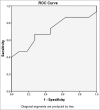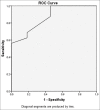Correlation of Urethral Ratio and Bladder Wall Thickness with Cystoscopic Findings in Posterior Urethral Valve Patients to Assess Residual Valves
- PMID: 35261514
- PMCID: PMC8853606
- DOI: 10.4103/jiaps.JIAPS_318_20
Correlation of Urethral Ratio and Bladder Wall Thickness with Cystoscopic Findings in Posterior Urethral Valve Patients to Assess Residual Valves
Abstract
Introduction: Posterior urethral valve (PUV) is life threatening congenital anomaly of urinary tract. Aim of the study was to correlate urethral ratio (UR) and bladder wall thickness (BWT) with cystoscopic findings in PUV patients to assess residual valves and to validate UR as a diagnostic tool for residual valves. It also aimed to assess the utility of bladder wall thickness in diagnosis of residual valves.
Materials and methods: A total of 31 patients were included in the prospective study done from 2017 to 2019. Calculation of UR was done in oblique VCUG films by dividing maximum posterior and anterior urethral diameter without the catheter insitu. Measurement of BWT was done at dome and bladder neck at full distension with feeding tube insitu and was done at same volume in follow up. The procedure was repeated at 3 months follow up. The findings were compared with cystoscopic findings for the status of residual valves as gold standard. Each patient served as control for self in the study.
Results: Median age of presentation was 1 years with range of 1day to 10 years. The most common complains at the time of presentation in our study was straining (35.48%) followed by antenatally diagnosed patients (25.81%) and recurrent UTI (19.36%). Pre fulguration median UR was 2.45. Post Fulguration median UR was 1.20. It showed a statistically significant reduction (p < 0.001) after fulguration. Pre fulguration median BWT was 4 mm. Post fulguration median BWT was 2.5 mm. BWT showed a statistically significant reduction (p < 0.001) after fulguration as well. ROC curve was plotted for UR and BWT. BWT more than 1.95 mm (sensitivity-80%) and UR more than 1.2 (sensitivity-70%) indicates residual valves.
Conclusion: A step ladder approach including BWT, UR and check cystoscopy can serve as a new diagnostic algorithm for the assessment of residual valves thereby avoiding extra radiation and general anesthesia exposure.
Keywords: Bladder wall thickness; congenital posterior urethral valves; cystoscopy; urethral ratio.
Copyright: © 2022 Journal of Indian Association of Pediatric Surgeons.
Conflict of interest statement
There are no conflicts of interest.
Figures







Similar articles
-
Justification For Re-Look Cystoscopy After Posterior Urethral Valve Fulguration.J Ayub Med Coll Abbottabad. 2017 Jan-Mar;29(1):30-32. J Ayub Med Coll Abbottabad. 2017. PMID: 28712168
-
Outcome of endoscopic fulguration of posterior urethral valves in children.Mymensingh Med J. 2009 Jul;18(2):239-44. Mymensingh Med J. 2009. PMID: 19623154
-
Posterior urethral valves: a single center experience over 7 years.Pediatr Surg Int. 2009 Mar;25(3):283-7. doi: 10.1007/s00383-009-2332-z. Epub 2009 Jan 29. Pediatr Surg Int. 2009. PMID: 19184051
-
Urethral ratio on voiding cystourethrogram: a comparative method to assess success of posterior urethral valve ablation.J Pediatr Urol. 2010 Feb;6(1):32-6. doi: 10.1016/j.jpurol.2009.05.009. Epub 2009 Jun 26. J Pediatr Urol. 2010. PMID: 19560402
-
Early ureteral surgery for posterior urethral valves.Urol Clin North Am. 1990 May;17(2):361-72. Urol Clin North Am. 1990. PMID: 2186541 Review.
Cited by
-
Care of children with posterior urethral valves after initial endoscopic incision/ablation: what a nephrologist needs to know.Pediatr Nephrol. 2025 May;40(5):1549-1564. doi: 10.1007/s00467-024-06553-9. Epub 2024 Nov 6. Pediatr Nephrol. 2025. PMID: 39503773 Review.
-
Impact of a standardized care pathway and a dedicated multidisciplinary posterior urethral valve clinic on 5-year kidney and bladder outcomes.Pediatr Nephrol. 2025 Jun 25. doi: 10.1007/s00467-025-06864-5. Online ahead of print. Pediatr Nephrol. 2025. PMID: 40560270
References
-
- Churchill BM, Krueger RP, Fleisher MH, Hardy BE. Complications of posterior urethral valve surgery and their prevention. Urol Clin North Am. 1983;10:519–30. - PubMed
-
- Elder JS. Management of antenatally detected hydroneprosis. In: Prem P, editor. Newborn Surgery. 2nd ed. London: Arnord; 2003. pp. 793–808.
-
- Cromie WJ, Cain MP, Bellinger MF, Betti JA, Scott J. Urethral valve incision using a modified venous valvulotome. J Urol. 1994;151:1053–5. - PubMed
-
- Hulbert WC, Duckett JW. Current views on posterior urethral valves. Pediatr Ann. 1988;17:31–6. - PubMed
LinkOut - more resources
Full Text Sources
